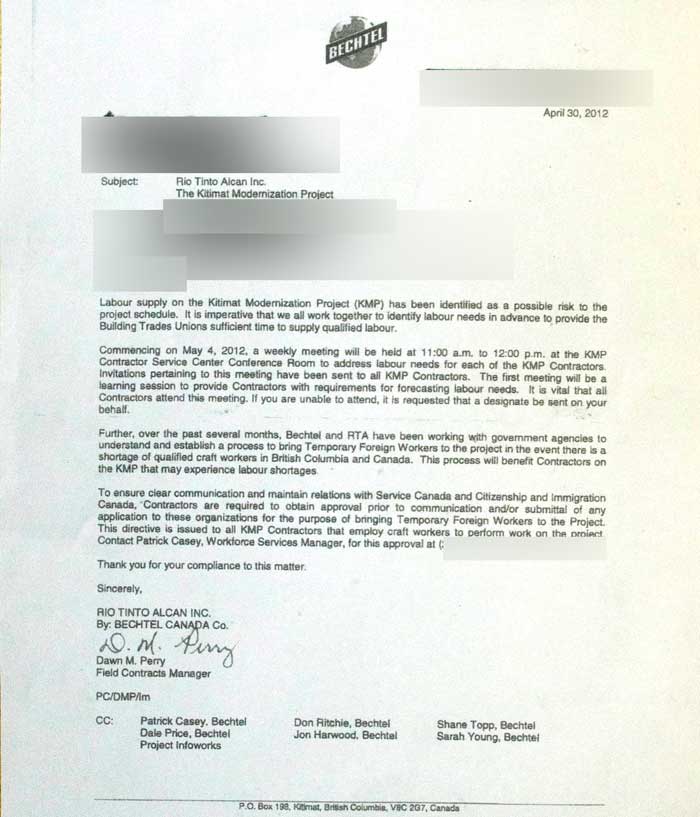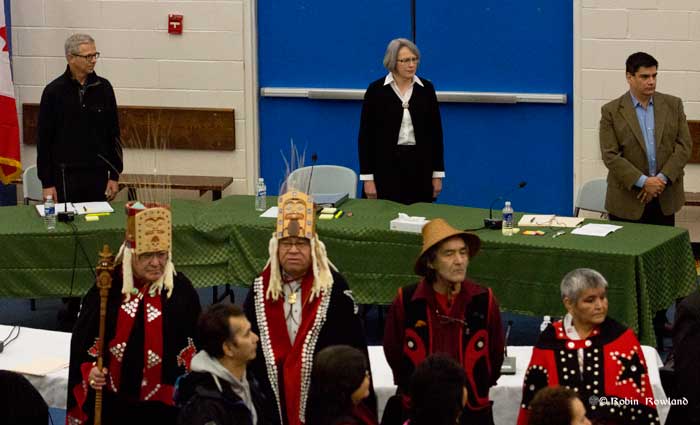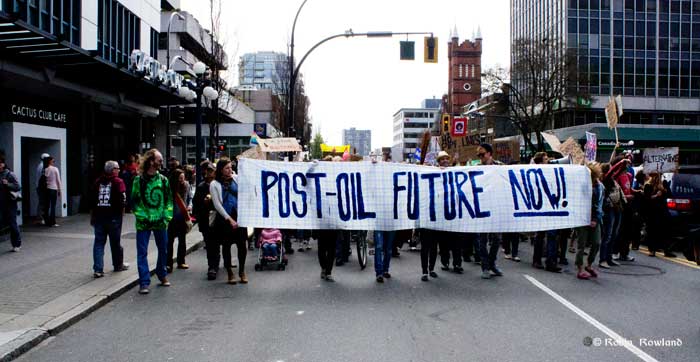American scientists studying the aftermath of the March 11, 2011, Tohoku, Japan earthquake and the resulting devastating tsunami say that a similar tsunami could be generated by an earthquake in the Aleutian Islands of Alaska.
The 9.0 magnitude Tohoku earthquake created a tsunami that was a high as 10-metres. The events killed about 18,000 people. Debris from the tsunami is now appearing on the west coast of North America.
The study, published May 8, in EOS, the Transactions of the American Geophysical Society, says:
A tsunami triggered by an earthquake along the AASZ [Alaskan-Aleutian Subduction Zone] would cross the Pacific Ocean and cause extensive damage along highly populated U.S. coasts, with ports being particularly vulnerable.
A subduction zone is where one tectonic plate, in this case, the Pacific plate, is forced down under another plate, the Alaskan continental arc.
Data from the Tohoku earthquake suggests that portions of the Alaskan-Aleutian Subduction Zone could be just as hazardous.
The study, by Holly Ryan, of the Pacific Coastal and Marine Science Center of the US Geological Survey in Menlo Park, Ca. and colleagues says the Japanese earthquake surprised scientists because the magnitude of both the earthquake and the tsunami were much larger than expected for the Tohoku region off northeastern Japan. The scientists say the region was originally considered low risk because the deep water section of the tectonic plate boundary that ruptured had been aseismic [a fault where there are no records of earthquakes] prior to the March 2011 event and was thought to be too weak to accumulate the strain to trigger a major earthquake.
In Japan and the Aleutians, there are seldom records of earthquakes where the upper tectonic plate is made up of weak, water-laden trench sediment accreted [stuck or locked] to the margin along thrust faults. The accreted sediment is not strong enough to fail in an earthquake (stick-slip behaviour) but, rather usually deforms without causing an earthquake.
Now research from the Japan shows that deep water section of the Tohoku region was fully
locked (accumulating strain at the convergence rate). The continental basement rock lies within
20 kilometres of the trench in deep water above the boundary at Tohoku. That created major accumulation of strain on the fault.
So when the earthquake occurred, there were large amounts of slip on the Tohoku megathrust, as well as corresponding movement on a deep water branch fault. Both contributed to the displacement of large volumes of water, creating the giant Japanese tsunami that smashed into the coast.
The Alaskan-Aleutian Subduction Zone is similar to the Tohoku region. The AASZ begins at a deep trench where the Pacific plate under thrusts the Alaskan continental arc and the Aleutian Islands oceanic arc.
Part of that subduction zone triggered the March 27, 1964 Good Friday magnitude 9.2 Anchorage, Alaska, megathrust earthquake. It was the largest quake ever recorded in North America and the second largest worldwide since seismic events were recorded. The epicentre was about 20 kilometres north of Prince William Sound, where a fault ruptured 25 kilometres below the surface. That quake causing major damage in Anchorage, 125 kilometres to the west and in Valdez 64 kilometres to the east. The megathursts along the ocean floor shifts created large tsunamis as high as 67 metres that struck along the North American coast from Alaska to California.
In Anchorage, nine people were killed by the quake, much of the downtown was destroyed and one neighbourhood lost 75 homes in a massive landslide. Two villages near Anchorage were destroyed when the land sank.
According to Wikipedia, the damage to British Columbia alone was estimated at $10 million in 1964 dollars (about $75 million in 2012 dollars according to the Bank of Canada inflation calculator) The Anchorage quake actually shook Kitimat and caused minor damage in the town. Due to factors such as the location of the quake at Prince William Sound , the tides and other factors along Douglas Channel, the tsunami coming into Kitimat was just a few centimetres high. Across the northwest and down the coast, there was more damage, the tsunami that hit Prince Rupert was 1.4 metres. Again to the configuration of the coast, tides and other factors, Port Alberni on Vancouver Island was hit twice, washing away 55 homes and damaging 375 others.
In California, 12 people were killed at Crescent City. There was damage in Los Angeles and as far off as Hawaii.
The study says that an Anchorage type event occurs every 900 years, so that area appears to be out of immediate danger,
According to the study, there was a magnitude 8.6 earthquake near Uninmak Pass in the same region in 1946 that triggered a tsunami that caused damage along the west coast, killed 150 people in Hawaii and inundated shorelines on South Pacific Islands and as far away as Antarctica. Another earthquake near the Andreanof Islands in 1957 also triggered a dangerous tsunami.
The new danger zone could be at the Semidi Islands, southwest of the better known Kodiak Island, where a 400 kilometre-long section of the subduction zone ruptured in 1938, causing a 8.2 magnitude earthquake. In the 1938 earthquake, the study says, that quake was beneath relatively shallow water, so it generated only a modest tsunami.
The Semidi Islands area is now fully locked, the study says, and enough strain has built up to trigger a similar event.
In 1788, a major earthquake in the Semidi Islands was recorded by Russian settlers. It is that area that the study says could trigger a Tohoku type tsunami. The segment of the trench in deeper water has not had a rupture since 1788. Satellite observations show that strain along the fault is accumulating “at a high rate.” The trench is four to five kilometres deep, just like at Tohoku, so displacement of the ocean water could trigger a similar giant tsunami.
Potential rupture of the near-trench section of the plate boundary is worrisome in that similar to the plate boundary near Tohoku, it is composed of rigid basement rock that extends beneath the margin to water depths of four to five kilometres. The presence of rigid basement rock close to the trench allows for an earthquake source beneath deep water, which would significantly amplify the height of the resultant tsunami. In addition, the possible additional rupture of an as yet undiscovered splay or branch fault, similar to circumstances during the Tohoku earthquake, would further increase the tsunami height.
The authors of the study call for more studies to compare the Aleutian area with the Tohoku region of Japan. Scientists are now working on “Paleotsunami studies” so there is a a history of tsunamis generated in the Aleutians that can be correlated to specific earthquakes.
Most of the attention on the west coast of North America has been centred on the Cascadia fault from northern California to southern British Columbia, which could also trigger a major earthquake and tsunami. It is time that scientists, emergency planners and government paid more attention to Alaska.
Link to Study Tsunami Hazards to U.S. Coasts form Giant Earthquakes in Alaska (pdf)
What about the Northern Gateway?
My family was just sitting down for dinner in Kitimat on that Good Friday evening in 1964 when the whole house began to shake. The quake in Anchorage lasted for four minutes, the shock that hit Kitimat was probably less than a minute.
After dinner, tuning to the local TV station, CFTK, the Friday night broadcasts was interrupted by a news special, an extraordinary even for a small station, which in those days had no microwave communications with the rest of the television universe, with the local anchor telling the story based on wire service and other reports that were already trickling in, giving the people of the Kitimat-Terrace-Prince Rupert region the news of the devastation in Alaska.
Fast forward 48 years and the big question on the northwest coast is the Enbridge Northern Gateway pipeline and whether or not the pipeline and the terminals in Kitimat harbour are vulnerable to earthquake and tsunami.
In public presentations in Kitimat, Enbridge officials have always minimized the potential danger to the Northern Gateway from earthquake and tsunami. In its latest presentation, to District of Kitimat Council on April 16, 2012, Enbridge engineer Drum Cavers told council that “all of the major earthquakes have occurred well off shore on the Queen Charlotte Fault,” and that “seismic activity is low relative to south coastal BC.” Cavers also said “the Kitsumcalum-Kitimat Valley is not the site of unusual seismic events or faults.” The presentation points to an 1973 quake in the Skeena River valley that Enbridge says was small and the planned pipeline is within “seismic design parameters.”
Cavers’ presentation said “No fault breaks to surface are known near the pipeline route, but if one should be found during further work, there are methods to mitigate fault motion if required.”
There has been no mention by Enbridge Northern Gateway of the potential problems that could be caused to the Kitimat pipeline and the terminal by a major earthquake or tsunami from the Alaska Aleutian region.
I was out of town during Cavers’ presentation but I have asked questions about the 1964 quake and potential problems from Alaska at three public meetings, including a direct question to Northern Gateway president John Carruthers at the September, 2011, public forum at Kitimat’s Mount Elizabeth Theatre. Despite promises, Enbridge has so far not responded to my questions.












